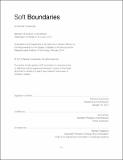Soft boundaries
Author(s)
Covarrubias, Daniela
DownloadFull printable version (40.52Mb)
Other Contributors
Massachusetts Institute of Technology. Department of Architecture.
Advisor
Joel Lamere.
Terms of use
Metadata
Show full item recordAbstract
Textiles have always played a critical role in the spaces we inhabit. Although textiles are often in opposition to what we consider to be architecture. Architecture is permanent, grounded, fixed; textiles are temporary, flexible, and portable. It is precisely those qualities of variation that allow us to directly modulate our surroundings, which is something we have long relied on textiles to do--not only as clothing, but also very much so in architectural contexts. Even the most iconic of modern architecture with its great expanses of glass and even greater claims of eliminating boundaries is nearly always accompanied by a curtain. In the realm of architectural textiles, curtains in particular go beyond the decorative. They are an essential element to the functionality of the architecture. Curtains have the ability to mediate light, sound, temperature, create spatial boundaries, and allow for direct and tactile interactivity. In taking on the curtain as an architectural element equal to any other, my goal is to employ the functionality and flexibility of textiles along with the language of curtains and expand it to design boundaries that can mediate between programs, but with their embedded variability, emphasize choice in the control of our environment.
Description
Thesis: M. Arch., Massachusetts Institute of Technology, Department of Architecture, 2014. This electronic version was submitted by the student author. The certified thesis is available in the Institute Archives and Special Collections. Page 169 blank. Cataloged from student-submitted PDF version of thesis. Includes bibliographical references (pages 166-168).
Date issued
2014Department
Massachusetts Institute of Technology. Department of ArchitecturePublisher
Massachusetts Institute of Technology
Keywords
Architecture.